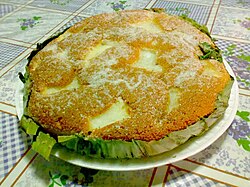Bibingka
 A large bibingka topped with grated coconut | |
| Course | Dessert, breakfast |
|---|---|
| Place of origin | Philippines |
| Serving temperature | Hot or warm |
| Main ingredients | Rice flour, water or coconut milk |
| Variations | Bibingka Galapong, Bibingkang Malagkit, Cassava Bibingka, Bibingkang Mandaue |
Bibingka is a type of rice cake from the Philippines traditionally eaten during the Christmas season. Traditionally cooked in clay pots lined with banana leaves.
Preparation
Bibingka is made with rice flour and coconut milk or water. Other ingredients can vary greatly, but the most common secondary ingredients are eggs and milk. The traditional preparation is very time-consuming. A specially made terra cotta container is lined with a single large section of a banana leaf. It is placed over preheated coals and the rice flour and water mixture is poured into it, taking care not to spill it into the container itself. Another piece of banana leaf is added to the top and covered with more preheated coals.


The end result is a soft and spongy large flat cake that is slightly charred on both surfaces and infused with the unique aroma of toasted banana leaves. Toppings are then added, usually consisting of butter/margarine, sugar, cheese, or grated coconut. Other more uncommon toppings include pinipig (pounded immature rice grains), pineapple, and salted duck eggs.[1] A mixture of two or more of these toppings on a single bibingka are also common. Bibingka with sumptuous amounts of toppings (and ingredients) are sometimes called bibingka especial.
More modern methods involve bibingka being baked in an actual oven inside a caldero or ordinary cake pans. The result lacks the distinctive smoky smell of charcoal but is otherwise the same, especially if banana leaves are also used to line it. Mass-produced bibingka in Philippine bakeries are also made using characteristic tin molds that give them a crenelated shape similar to large puto or puto mamon (cupcakes).
Bibingka is best served hot. Large bibingka can be sliced (or torn) into several wedges and can serve 4 to 6 people.
Taste and texture
Bibingka has a soft spongy texture similar to puto, another Philippine rice cake. It is eaten hot or warm and is slightly sweet with a taste very similar to rice pudding. The top and bottom surfaces (including the traditional banana leaf lining) are also usually charred, adding to the flavor.
Origins and variations
Bibingka is also used as a general term for desserts made with flour and baked in the same manner. The term can be loosely translated to "[rice] cake". It originally referred primarily to bibingka galapong, the most common type of bibingka made with rice flour. Other native Philippine cakes have also sometimes been called bibingka. These may use other kinds of flour, such as corn flour, cassava flour, or plain flour, and are usually considered separate dishes altogether.[2] Bibingka can also be made with uncommon ingredients, including chocolate. According to the anthropologist E. Arsenio Manuel, bibingka, like biko (another Philippine dessert made from glutinous rice), is the result of Chinese influence on Filipino culture. The name comes from the Hokkien root word "bi" (米, 'uncooked grain').[3]
Despite the similarity in name, the Philippine bibingka is not the same as the Goan dessert called bebinca or bibik, which is a type of layered pudding and made with regular flour.
Most varieties of bibingka differ only from the type of toppings they use. The common types of bibingka are listed below:
- Bibingka galapóng is the traditional form of bibingka made from tamod.[4] It was originally made simply with rice flour and water.
- Bibingkang malagkít is made from glutinous rice flour.[4] It is moist and is usually served sliced into square blocks.
- Bibingkang Mandaue (Mandaue-style Bibingka) are bibingka from Mandaue, Cebu. It is traditionally made with tubâ (a liquor made from Arecaceae sap) which gives it a slightly acidic aftertaste. Nowadays, tubâ is often substituted with yeast.[5]
- Bibinkang kamoteng kahoy is made from cassava flour, and resembles pudding the most. However, it is more widely known simply as cassava cake.[2]
 |
 |
 |
 |
Bibingka in Filipino culture
Bibingka is a traditional Philippine Christmastime food. It is usually eaten along with puto bumbóng right after the Simbang Gabi ('Night mass', the Filipino version of Misa de Gallo).[1] They are sold outside of churches during the nine-day novena for worshippers to eat for breakfast.
As of October 9, 2007, the town of Dingras, Ilocos Norte in the Philippines is expecting a Guinness World Records certification after baking a kilometer-long cassava bibingka made from 1,000 kilos of cassava and eaten by 1,000 residents.[6] Also, in the municipality of Baliuag, Bulacan, bibingka is served along with salabat (ginger tisane) and the stores selling them serve them for free.
See also
References
- ^ a b Jun Belen (20 December 2010). "Feeling Sentimental and How to Make Bibingka (Christmas Rice Cakes)". http://blog.junbelen.com/. Retrieved January 6, 2011.
{{cite web}}: External link in|publisher= - ^ a b Connie Veneracion (March 2, 2007). "Cassava bibingka with custard topping". Casa Veneracion. Retrieved January 10, 2015.
- ^ "Sweet and Sticky Pinoy Treats: Our Top 10 Kakanin". http://www.spot.ph. 22 June 2010. Retrieved January 6, 2011.
{{cite web}}: External link in|publisher= - ^ a b "Bibingkang Galapong and Bibingkang Malagkit – Triumph & Disaster". http://www.marketmanila.com. 25 August 2006. Retrieved January 6, 2011.
{{cite web}}: External link in|publisher= - ^ "Bibingkang Mandaue". http://www.marketmanila.com. 17 October 2006. Retrieved January 6, 2011.
{{cite web}}: External link in|publisher= - ^ Abs-Cbn Interactive, Ilocos Norte town makes 'longest bibingka'

